Couples Are Completely Rewriting Tradition With These 2025 Engagement Trends

Gone are the days of ring shopping alone or planning a spur-of-the-moment engagement. The latest results from The Knot 2024 Jewelry and Engagement Study indicate that couples are completely rewriting the traditional "rules" that accompany proposals by tackling this milestone together, and they're having so much more fun in the process. We collected data from over 7,800 couples in the US about their proposal experiences, and their responses depicted a compelling story about the state of what it means to get engaged today.
From collaborative ring design appointments to lavish engagements that cosplay as mini weddings, our study indicates that couples will continue to change the game when it comes to popping the question in 2025. Here are some of the most fascinating proposal and engagement trends we've uncovered, straight from fiancés across the nation.
The Top Proposal Trends of 2025:
- Prep Begins More Than a Year in Advance
- Couples View the Engagement as Joint Endeavor
- Pinterest Delivers the Most Ring-spo
- Shopping for the Ring? Make a Few Stops
- The Cost of the Ring Decreases While Size Increases
- Lab-Grown Stones Are Becoming More Common
- A New Center Stone Shape May Soon Dethrone Rounds
- Oh, the Places They'll Go (to Get Engaged)
- Some Proposal Traditions Never Waver
- Wedding Prep Begins… Right Away
Proposal Prep Begins More Than a Year in Advance
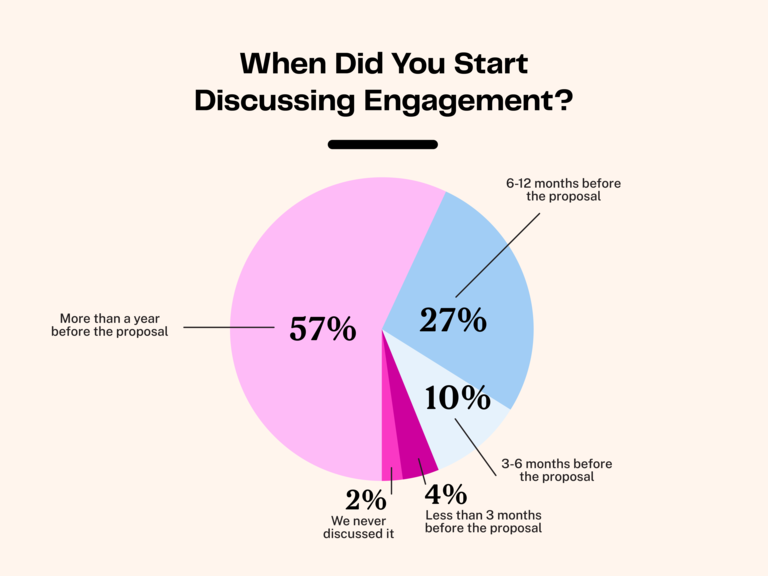
While we won't deny there's beauty in simplicity, most people view their proposal as something that can't happen at a moment's notice. According to The Knot 2024 Jewelry and Engagement study, over half of all couples (57%) began discussing their engagement more than a year before the proposal. Once plans were ready to be put in motion, about 83% of proposers prepared for their engagement ahead of time. (Only 13% reported that it was a spontaneous gesture.) Of those who planned early, just under half of that group spent one to three months planning the special moment. These numbers have barely fluctuated over the years, indicating this is one proposal trend that won't falter. After all, you only get engaged once: it should be a special experience worthy of your time and energy.
Couples View the Engagement as Joint Endeavor
Most proposals have some element of a shock factor. (That is a huge component of engagements, after all.) Our data shows that 83% of proposees considered it a surprise. Of that, however, over half reported that they knew a proposal was coming soon, but just weren't sure exactly when. What's compelling, though, is the level of involvement both partners have when it comes to selecting the ring. We found that 39% of proposees were "somewhat involved." How? By hinting at what sort of design they wanted. Twenty-nine percent said they shopped with their partner, and 9% were there when the actual ring was purchased.
The responses indicate a shift away from past cultural norms. While your parents or grandparents might not have had such candid conversations about their next steps as a couple, our data shows that being on the same page about the proposal before it happens is a must for the majority of people.
Pinterest Delivers the Most Ring-spo
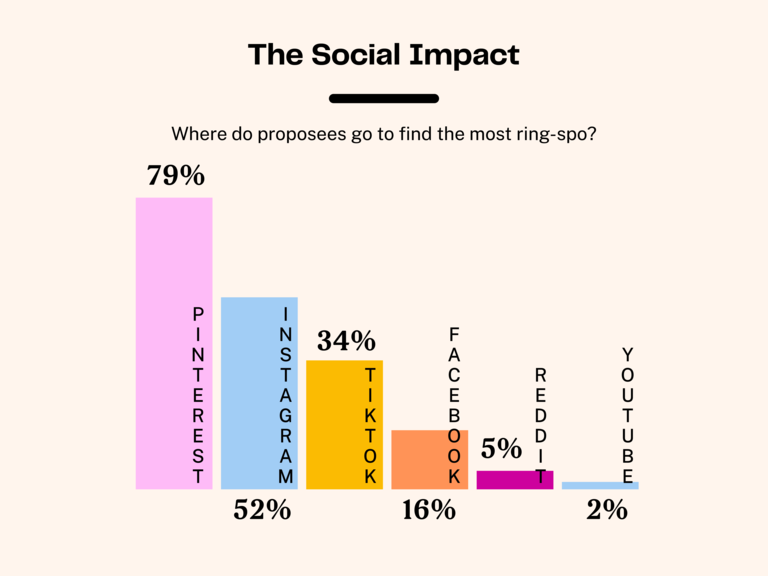
Of those proposees who conducted engagement ring research ahead of time, 79% turned to Pinterest or other social media sites for ring-spiration. (To emphasize our point: That's nearly 4 out of 5 proposees consulting social media for guidance!) While Pinterest was the most popular destination among social media platforms, 62% got ideas from Instagram. Of course, we know you're wondering about the Gen Z-boosted app TikTok: about 34% used the shortform video platform, an increase of 5% since 2023. (It's never too early to get your FYP on #WeddingTok.)
In total, 77% of proposees said they had some form of involvement in selecting their engagement ring. And we encourage it: be it through subtle hints or not-so-indiscreet directives.
Shopping for the Ring? Make a Few Stops
Of course, buying an engagement ring is an important (and pricey) investment—and our data confirms that proposers are doing their due diligence to get it right. We found that 31% of proposees researched their ring preferences over 12 months before the proposal took place, leaving plenty of time for the proposer to make the purchase. Per our data, 75% of them spent about four months on the entire shopping experience.
Now, though, proposers are going to more retailers before making that final decision. In 2024, they visited an average of five retailers before making the purchase. That's quite the increase from 2023 and 2022, when shoppers went to just two on average. Decisions, decisions.
While there was a shift toward online engagement ring purchases during the COVID pandemic, proposers are back to valuing interactive experiences. Interestingly enough, 71% agreed that it was important to them to shop in person, and 68% said it was important to see the ring in person prior to purchasing it.
The Cost of the Ring Decreases While Size Increases: Here's How
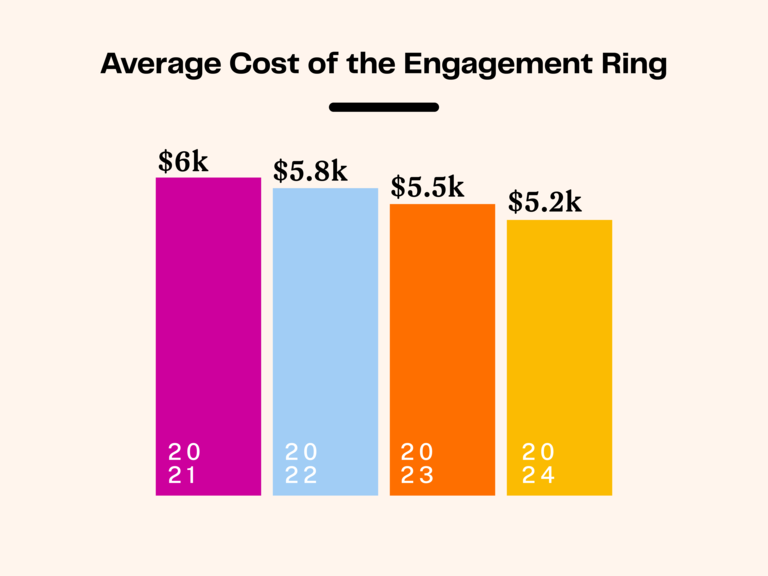
Arguably one of the most shocking stats from our study may not come as a surprise to the masses at all. Price is officially the most important factor to proposers when looking for engagement rings. (In this economy, there's a reason why. Historically and for context, respondents ranked the cut/shape as the most important feature over price. They wanted to get their partner's dream rock, after all.) However, in 2024, proposers ranked price as the most important quality, followed by cut/shape as the second and quality as the third.
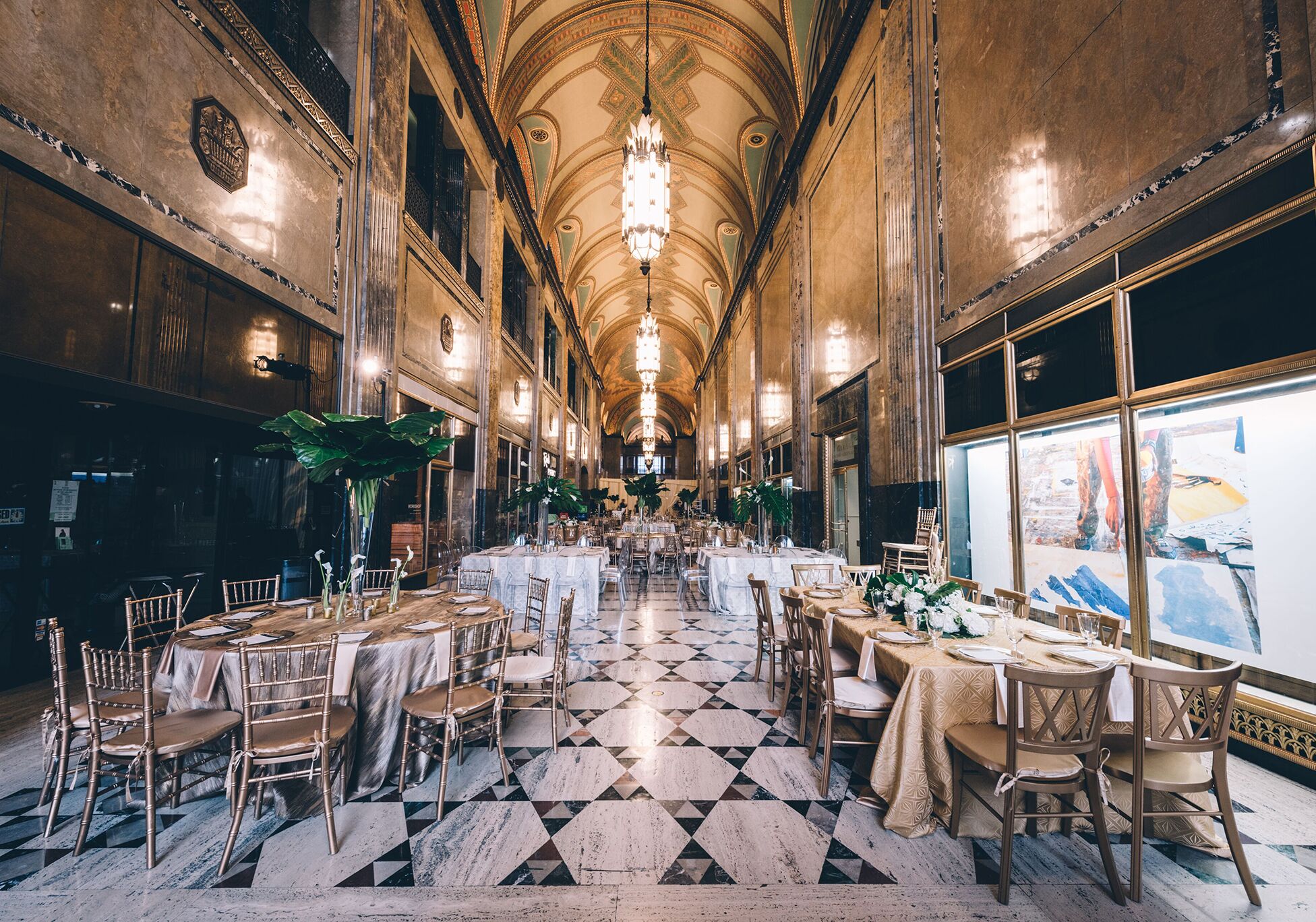

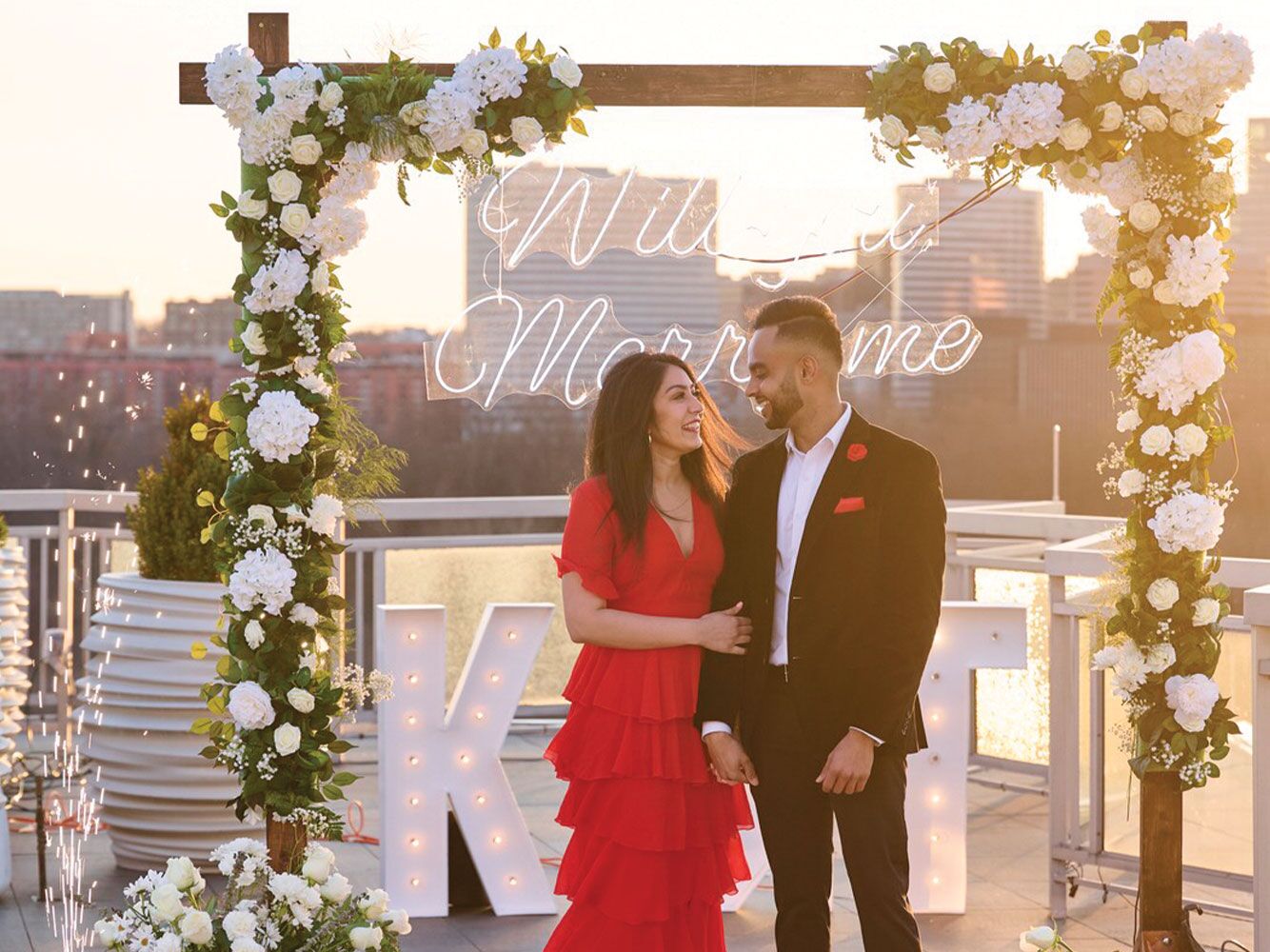
What's more? They want to maximize the value of their purchase. With inflation concerns affecting consumers across the country, this shift doesn't come as a complete surprise. Further fueling this new engagement trend is the fact that the average cost of an engagement ring has been steadily decreasing over the years. Our survey found that shoppers now spend an average of $5,200 on their proposal piece. That number was $5,500 in 2023, and $5,800 in 2022. Back in 2021, it was a whopping $6,000.
What's fascinating, though, is that the average carat size has increased. Our 2024 survey indicates that the average carat size of an engagement ring is 1.7 carats, up from 1.6 in 2023. However, a majority of engagement rings also feature side stones or additional gems within the setting, meaning rings continue to increase in overall size. Now, nearly 40% of engagement rings feature stones that are over 2 carats. This represents a 22% spike since 2015.
Lab-Grown Stones Are Becoming More Common

So, how are people investing in more carats while paying less? The answer could be explained by the rise of lab-created diamonds. Our data reveals that over half (52%) of all engagement rings feature a lab-grown center stone, which is up 6% from last year. Looking further back, lab-grown diamonds made up just 12% of engagement rings in 2019, showing just how quickly this trend has skyrocketed. Meanwhile, 22% of respondents in 2024 reported that their ring has a mined diamond, down 3% from the previous year.
The choice between the two is now one of the golden questions that accompany an engagement ring purchase. One of the biggest differences is that lab-grown diamonds cost less than mined diamonds because they aren't finite materials. While there's only a limited number of diamonds that can be pulled from the earth, an unlimited amount of diamonds can be grown in a laboratory setting. There are plenty of other considerations to keep in mind when deciding between these two types of diamonds, such as the market value of each stone. With so many different variables, the selection between these options is a deeply personal choice. But because our data indicates that proposers are highly aware of their overall spend, the lower price tag of lab-grown diamonds may be perceived as an attractive quality for the 52% who went for lab-grown center stones in 2024.
A New Center Stone Shape May Soon Dethrone Rounds
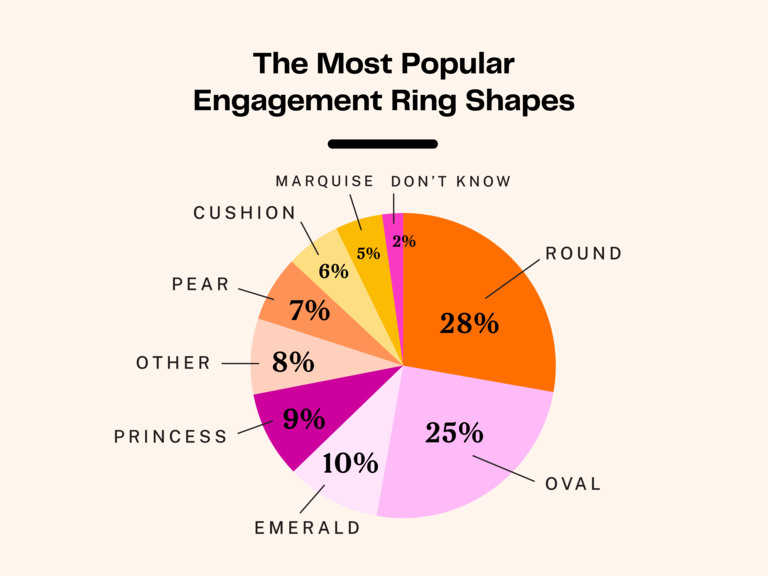
For years, round-shaped diamonds have been the most popular engagement ring style in the US—but that may be replaced by a new shape very soon. Twenty-eight percent of engagement rings feature a round center stone, but the second most popular shape is the oval, which accounts for 25% of all designs. That's up a staggering 23% since 2015, when it was seen in just 2% of engagement rings.
While many jewelers and pop culture savants consider A-listers like Blake Lively, Hailey Bieber and Kourtney Kardashian to be catalysts for this trend, it's not the only reason people are drawn to this shape. Ovals tend to show their carat weight well, so they can appear larger than their actual size. Plus, the elongated appearance is a finger-flattering shape. While time will tell if the round is ever *officially* unseated, this massive change could happen sooner than we realize.
Oh, the Places They'll Go (to Get Engaged)
Beyond general ring details, our study also dove into the nitty gritty of what actual proposals look like for real couples. And while the "perfect" engagement plan will look different for everyone, we were able to identify a few key trends. We found that 53% percent of all proposals were private, taking place with just the couple. Thirty-nine percent of proposals were in a public place, while 28% occurred in front of friends and family.
We found that 34% of proposals took place at a "scenic" spot, while 17% of couples reported that the location had a special meaning (i.e. the spot of their first date, the place they shared their first kiss, etc.). Other popular engagement settings for couples took place on vacation in the US (14%), during an outdoor activity (14%), at home (14%), on the beach (14%), or at a public garden/park/zoo (11%). Eight percent took place while on vacation abroad, 7% occurred in front of a famous landmark, 5% were in a restaurant or bar, and 5% were in front of friends and family.
Some Proposal Traditions Never Waver
Despite the many different places couples got engaged, select traditions rang true for nearly all. Per our data, 89% of people proposed with a ring in hand, while 85% got down on one knee. Eighty-seven percent of people said the words, "Will you marry me?" and 69% asked for parental permission. Looking back, 57% of couples said they cried during the proposal (I mean, I would too), while 54% said the experience was "unique."
One in five proposers hired a secret photographer to capture the occasion (for the mems, of course), while 5% included their pet, and 5% hired additional vendors (such as musicians, a videographer, a planner, etc.) to make the experience truly memorable.
Wedding Prep Begins… Right Away
After the proposal, couples are letting the adrenaline of getting engaged propel them into wedding planning. Over half (57%) of all couples reported that they began planning their nuptials less than one month after the proposal, while 23% began planning one to two months later. In total, that means 80% of fiancés are beginning to plan their wedding within two months of their engagement. And, honestly, we don't blame them! With so many exciting wedding trends on the horizon, planning one is more fun than ever before—so why wait?




















